A few things to consider when purchasing foul-weather gear are your intent of purpose, the fit of the gear and its safety features. Quality and price are equally important, but before you shop, have an idea of the conditions they will be protecting you from.
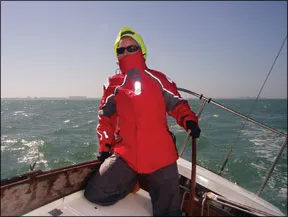
How long do you plan to wear it (an hour, one day, several days at a time)? Do you intend to spend six months off Maine, or do you need an extra set for a visitor on your boat in Florida?
Our mens foul-weather gear review (February 2008) discussed what to look for when selecting foulies.
A quality jacket-bibs set should be, above all, dry and comfortable. Our testers found that the fit of the jacket and the hood directly affect performance, so look for a good fit around the neck and face. Throughout the test, the hoods were a fit issue that testers found to be relative to each persons noggin. Waterproof-windproof gear with comfortable, effective zippers and wrist and ankle closures is a must. When its time to reef, you’ll want a zipper that’s easy to grasp and easy to use even with gloved hands.
What We Tested
We chose seven foulie sets that fit our test criteria: a mid-level jacket and bibs/pants appropriate for coastal cruising and light offshore sailing. Most of the manufacturers of these products also offer higher-quality, more-expensive gear, but we set a maximum budget of $500 for the full kit and aimed for the mid-range offerings.
Four of the outfits we tested are designed specifically to fit women. Those are made by Gill, Gul, Helly Hansen, and West Marine. Test gear from Plastimos XM Yachting and Ronstan lines were unisex designs. From what we could tell “unisex” is virtually the same as “mens small.”
Before looking at individual kits, we pause one moment to rant: It is obvious from our men’s and women’s foul-weather gear tests that fashion-driven design has yielded jackets without any high-visibility colors, except in the hood. If we lived in a world where we always had time to don our high-visibility life jacket or deploy our hood when we go overboard, this would be fine. We don’t.
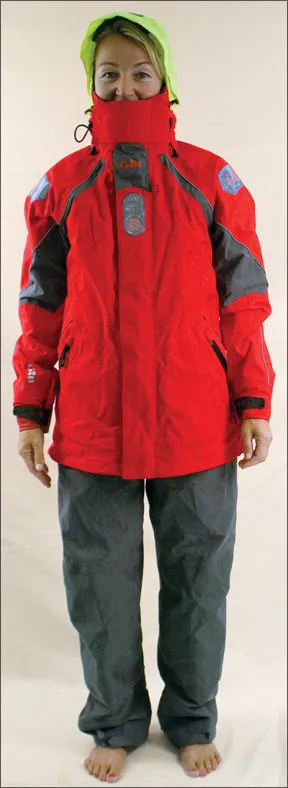
At the minimum, a true sailors jacket should have reflective tape and proven high-visibility colors-bright orange, yellow or day-glow green-from the chest up. Red is a poor second choice. Black and grey are unforgivable. Most of the jackets in this test offer a high-visibility color combination, though not as bright as we would like.
Gill Key West
The Gill Key West jacket (OS5J) and bibs (OS5T) are well-made, high-quality foul-weather gear that would perform well as either coastal or offshore gear.
The Key West’s little extras-like the double storm flap along the jacket front, fleece-lined pockets on both the jacket and bibs, and fully-taped seams-made a big difference in performance and comfort. Gill’s high-cut, fleece-lined collar offers comfortable full-face (and ear) protection.
Although there were small details that raised concerns during our testing, overall, the Key West coat performed very well in the wind and water field tests. It and the bibs proved to be breathable yet waterproof and windproof in real-world conditions.
The jacket had one of the snuggest fits in the test. (We tested a size 8 on women who wear sizes 6 and 8.) Ordering up a size would be a good idea to leave ample room for a fleece or thick sweater underneath.
The Key West jacket is shorter than a typical-length coat. Unlike the other jackets we tested, it isn’t long enough to sit on. According to Gill, it was intentionally cut shorter, to allow more freedom of movement-but the bibs have reinforced material for added protection at the seat.
The Key West has plenty of storage and hand-warming space. Tucked under the jacket’s unlined, zippered cargo pockets are fleece-lined slash pockets that are warm and deep. There is also a small, zippered pocket beneath the storm flap.
The jacket’s bottom and ankle cuffs are mesh-lined, and its double wrist cuffs are easy to adjust and kept most of the water out during field tests. The jacket has a plastic, two-way oversized zipper. There is also a lanyard and D-ring inside one pocket.
As far as safety features, the jacket offers multiple high-visibility Reflexite reflective patches on the jacket hood, shoulders, chest, and wrist, and both the jacket and bibs have prismatic piping.
Testers found that the fluorescent-yellow hood fit tightly and sat too high on the head. Gill explained that the hood is snug to allow it to move with the head. Its angled sides allow for enhanced peripheral vision.
The bibs are cut for a womans shape and have an elasticized waist for a better fit. The drop-seat pants have a reinforced seat and knees, Velcro seals at the ankle cuffs, and fleece-lined warmer pockets. Testers noted its infinitely adjustable (via Velcro) straps had a tendency to rub at the shoulder.
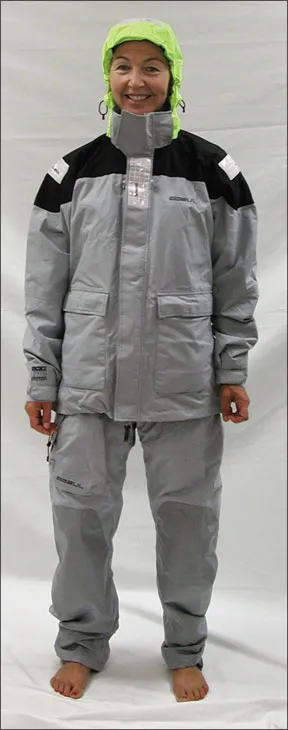
A main concern with the Gill bibs was its strap-adjustment ring. The threads holding the plastic ring to the bib front pulled out after very little use during our testing. This sort of damage is covered under Gills limited lifetime warranty.
Bottom Line: The Gill Key West set was one of the top performers in all tests, and only its higher price ($450) kept it out of the top slot. We highly recommended it for those able to spend more.
Gul Newport
The Gul ladies Newport Jacket and Drop Seat Trousers Hi Fits are lightweight, good-looking, and comfortable. This set had the best overall fit for all women testers. This made them attractive on and also addressed performance issues that rely on fit. The jacket is marketed as performance gear and seems a good match for racers and active sailors.
One tester found the high-visibility fluorescent hood a good fit, another found the fitted, adjustable hood too small, and yet another could not adjust it enough to keep wind and water out. The jacket has a mesh lining, good interior and exterior wrist closures, and plenty of reflective patches and prismatic piping. However, the color scheme tested-dark shoulders and grey sleeves-offered poor visibility.
Although the jacket was the most comfortable and easiest to move in, testers could feel the wind through the jacket. In our opinion, the jacket would be good for inshore racing, tropical cruising, and day sails. We would prefer a higher, warmer collar and a heavier jacket for offshore adventures. Gul Senior Designer Warren Valentine told Practical Sailor that the company is working to improve the jackets wind resistance. “We have developed a new wicking, brushed-mesh lining that slightly lifts the outer fabric, providing more wind resistance without effecting breathability,” he explained.
The bibs are streamlined, comfortable, and good-looking. The reinforced patches carry all the way down to the ankles, with comfortable, effective Velcro adjustments at the bottom. The Velcro suspender straps are quick and easy to adjust. But the no-toggle, no hook Velcro system might suffer after long-term wear and tear. There is a slash pocket on the thigh with a protected zipper, along with two fleece-lined pockets, a wonderful extra. The bibs are streamlined and well designed and would be a nice match for racers, with or without the Newport Coastal jacket.
Bottom Line: The fit was the best for women, and the bibs were among testers favorites. Although a little light for offshore, we recommend it for inshore racers and warm-climate sailing. Wed chose the higher-visibility yellow-steel suit.
Helly Hansen Fjord
True to the Helly reputation, the Helly Hansen Fjord jacket and bibs look sharp. At first glance, testers were skeptical of the jackets stylish cut and colors, its aprs-sail appeal, and gimmicky Aquapac pocket. As it turned out though, both the jacket and bibs performed very well in the wind and water tests.
The jacket has a double storm flap and three layers of protection around the neck and face. Testers would like to see the collar and interior Lifa fleece rise slightly higher for more coverage and face protection, but testers necks did stay dry during the tests.

The zippers are small, but have a large, easy-to-grab pull tab.
The Fjord was the only jacket with an Aquapac-a pocket sewn onto the outside of the upper sleeve intended for cell phones and other small gadgets. The Aquapac was a bust on our testers jacket-it broke within minutes of our trying on the Fjord jacket.
But the jackets other pockets served well. There are several well-placed, waterproof, zippered pockets, including fleece-lined ones at the chest and inside the storm flap, Velcro cargo pockets on the jacket front with fleece-lined slash pockets underneath, and a small, lined, zippered pocket inside of the jacket.
The jacket is lined with mesh and taffeta, and testers found the interior Velcro wrist closures to be the most comfortable and versatile.
It was the only jacket tested with hidden fluorescent-yellow forearms. (See photo, above.) While useful for signalling on deck, the sleeves will be of little use while a victim is treading water.
The Fjords other safety features were above average. The jacket is literally covered with reflective patches and piping, and the hood is a vivid yellow. It was the only jacket tested with a whistle attached. Some testers found that the hood, which lacks a hard brim or peak, drops too low over the face, while others were able to adjust the fit.
The taffeta-lined bib trousers have a reinforced seat and knees. They have an elasticized waist and adjustable cuffs and reflective patches at the ankles. Testers liked the quick-release, easy-to-adjust plastic tabs on the suspenders. (See photo, above.) They are innovative, sturdy, and easy to use.
The jacket and trousers (womens size small/petite), fit our size 6 tester perfectly. But our size 8 tester found them a bit too snug and a bit too short.
Bottom Line: Testers looked good and stayed warm and dry in this set, but wed opt for the higher-visibility red-and-white combo. Performance was at the top of the field, and price was in the middle of the pack, making the Fjord our Best Choice.
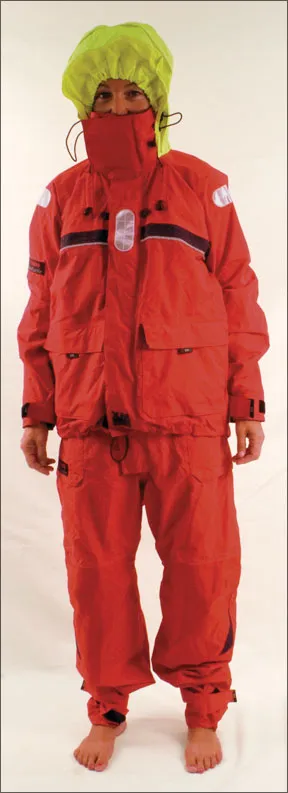
Plastimo XM Coastal
We reviewed two sets of XM Yachting foul-weather gear, one XM Offshore set and one XM Coastal. Both were a unisex (mens) size small, and fit was an issue.
The pants are very unflattering to a woman, but understandably, as they are designed for a man. Although the rear end is gigantic, the fit in this case doesn’t seem to affect performance.
The Plastimo XM Yachting Coastal Jacket is lighter weight than Plastimos XM Offshore. The jacket, wrists, and ankles have a mesh lining, and the mens small jacket has a slightly loose, comfortable fit. Although it has limited reflectivity, with no patches and only limited piping, the jacket has a hydrophilic coating and repels water.
The XM Coastal jacket has a fleece flap between the zipper and the face, so the wearer has a layer of soft fleece against the skin instead of a zipper. It has a comfortable hood with a nice peak, but testers couldnt adjust the fit to keep wind and water out.
The bib suspenders are easy to adjust and have high-rise T-back straps that don’t slip, with an elastic waist and elastic under the arms. They have just a touch of reinforcement on the knees and seat and an uncovered zipper on the front. There is one non-draining cargo pocket on the thigh.
Like the XM Offshore, the pants are very unflattering to a woman but they are comfortable and easy to get on and off, and they stay dry.
Bottom Line: Lighter weight than the XM Offshore, this set is comfortable and performs well but it has fewer features.
Plastimo XM Offshore
Our size-6 woman tester was swimming in the Plastimo XM Offshore trousers, although the Offshore jacket was adjustable and fit fairly well. It has a comfortable, high, fleece-lined chin flap that rises 18 centimeters from the zipper and covers the face, chin, and ears. But, because the fit was a bit big, testers found that wind tended to funnel down the collar.
The jacket has two layers of hydrophilic coating and repels water well. It feels heavier than others tested and, although breathable, it may perform better in temperate rather than tropical conditions.
The jacket wrists and ankles are mesh lined. The wrists have interior and exterior Velcro cuffs, and the ankles have Velcro cuffs. The jackets slash, hand-warmer pockets are lined, but not with fleece.
The hood is a drawback: Testers found it confusing with multiple layers and two brims. Although it is a vivid yellow and has an extra reflective patch, there is so much spare material its almost like a chefs hat.
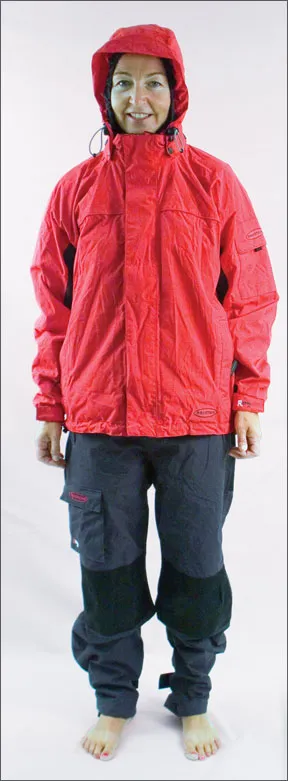
The bibs have a reinforced seat and knees, and the easy-to-adjust suspenders are comfortable with T-back straps that don’t slip down. The pants have two cargo pockets, and the high-fit waist has elastic sides for ease of motion and comfort.
Bottom Line: Although there are a couple of shortcuts (no fleece in pockets, zippers take a little more fidgeting to get up, less breathability), the XM Offshore was one of our top performers in testing. Heavier and warmer, it would work well in temperate climates. It is our Budget Buy. Consider matching the jacket with a better-fitting pair of bibs from another maker.
Ronstan Inshore
The Ronstan Lightweight Inshore jacket is exactly what its name implies: It is a breathable, lightweight jacket suited for inshore, leisurely day sailing or short-course racing.
The fleece-lined collar sits low on the neck and does not provide much protection from wind, but the adjustable hood was the most effective in the field. The hoods toggle adjustments and full-face brim kept rain out of testers eyes and out of the jacket better than the other jackets.
The jacket kept testers dry, but we could feel the wind make its way up the wrist closures, through the collar, and bite through the fabric. The jacket has two zippered, fleece-lined front pockets, one Velcro sleeve pocket, and a zippered pocket behind the storm flap.
The Ronstan trousers were the only ones in the test field that did not have suspenders; they were regular mens small pants with a zipper and a snap. The waist cannot be cinched tight enough to properly fit a size 6 woman, and the pants legs are too long, even fully adjusted.
Bottom Line: The Ronstan Lightweight Inshore suit is entry-level gear that is comfortable and well priced.
West Marine Third Reef
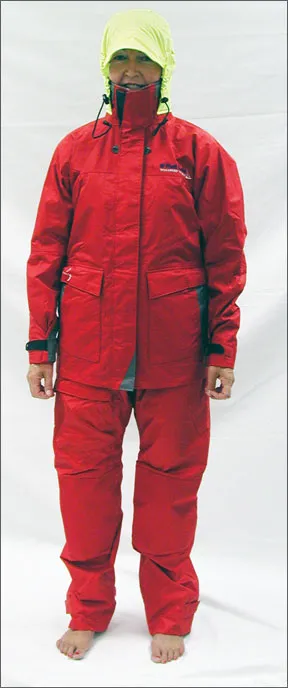
West Marine markets this suit for daily use in mild and moderate conditions with a light rain, spray, or wind. Testers agreed that it was not intended for, and would not perform well, as an offshore set.
Both pieces have a comfortable and relatively flattering fit for women. Although advertised as breathable, the jacket and pants felt heavy and testers found them to be quite hot. There is no mesh lining in the jacket.
The exterior of the pants and jacket has a water-resistant hydrophilic coating that kept testers dry, but wind cut through the fabric and funneled down the collar and through wrist closures. The jacket has a good fluorescent-yellow hood with a brim, but no reflective material. It has small zippers that are hard to grasp. The pockets have a fleece lining on one side only.
The Third Reef drop-seat bibs fit a womans shape nicely and are lined with mesh drains at the ankles. There is a thigh pocket, and the seat and knees have a sturdy reinforcement.
The bibs also have decent Velcro ankles closures. The suspender straps are a bit thin, but seem to do the trick. They have buckles for quick doffing and donning and protected zippers along the sides.
Bottom Line: The Third Reef set offers some protection but doesn’t totally block wind and water. Although it comes with a very competitive price for an entry-level set, the jacket is better suited for the first reef.
Conclusion
Take a good look at the fit before choosing your foul-weather gear. A quality set that doesn’t fit around the neck, wrists, and ankles wont do its job.
The Helly Hansen Fjord, Gill Key West, Gul Newport, and Plastimo XM Yachting Offshore were our favorites. The Key West set was the most expensive but its quality gear, and we recommend it. The Helly set is more versatile and gets the Best Choice pick.
The Budget Buy goes to the heavy-duty Plastimo XM Offshore gear. (The bibs are a poor fit for women, but it doesn’t affect performance.) For those looking for lightweight gear, we recommend the Gul Newport.
Look at the price and fit of each piece. Consider mixing and matching jackets and bibs from different manufacturers-i.e. the Gill jacket with the Gul bibs-to meet your fit and financial needs. Determine what you will use it for: If you will be wearing it just a few days on Florida bays, don’t over-invest. But if you know you will be faced with cold, wet, or windy weather, don’t buy cheap foul-weather gear. You will regret it.




































Sadly! I have to keep looking. The pants are always too long. None is offering a “short” version. I will have to keep using ski pants (where most of the manufacturers understood years ago and are offering short/regular/long inseam versions).
On their website, Gil is suggesting to petite women to go check their junior trousers. Really? Come on! The rectangle shape of a kid garment does not fit a curve women body.
Where should I go to find a manufacturer offering trousers that fit shorter women?